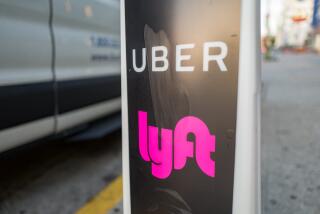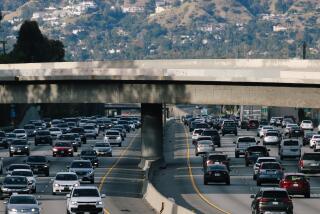The Uber insurance gap
In the new world of the sharing economy, companies such as Uber, Lyft and Sidecar have made a compelling case that government shouldn’t treat them the same way it treats conventional service providers. They’re not taxi companies; instead, they empower people to act as part-time limo drivers. But regulators still have to make sure that the public is protected when something goes wrong. A recent fatal accident involving a driver who used Uber highlights gaps in the insurance coverage that ride-sharing services, their drivers and state regulators can’t ignore.
The ride-sharing companies offer smartphone apps that enable freelance drivers to provide rides for a fee, which they split with the company. They’re regulated by the state Public Utilities Commission, whose requirements include a mandate to carry liability insurance to supplement drivers’ policies.
On New Year’s Eve, a driver who freelanced for Uber struck three pedestrians, killing a 6-year-old girl. Her family sued the driver and Uber, which argued that it bears no liability because the driver hadn’t been retained by an Uber customer at the time of the collision. But the driver insists that he was working for the company at the time because he was running the Uber app, waiting for a request for a ride.
The driver’s status affects more than just his liability. As the state Department of Insurance recently warned, the policies held by many drivers won’t cover accidents that happen when they’re providing rides for pay. It’s not clear where insurers will draw the line between commercial and noncommercial activity; as the accident in San Francisco illustrates, the line is blurry, and it will only become blurrier as more people sign up to be occasional drivers for these services.
Worse, the insurance coverage mandated by the PUC doesn’t require ride-sharing companies to insure against collision damage to the driver’s vehicle, injuries to the driver or losses caused when the car is hit by an underinsured motorist. Lyft announced Wednesday that it was adding coverage for underinsured motorists and for collisions but not for injuries to drivers — that will have to come from drivers’ health insurance, assuming they carry it. Uber also offers coverage for underinsured motorists. But the companies are doing so at their discretion, which means they can drop the coverage at any point.
Ideally, pressure from riders will prompt ride-sharing companies to close the coverage gaps, and insurers will develop policies for drivers who carry riders on a part-time basis. The PUC should help move that process along, though, by requiring ride-sharing companies to clearly disclose to drivers and riders the risks they will be assuming. It should also be prepared to expand the insurance requirement if the coverage gaps persist.
More to Read
A cure for the common opinion
Get thought-provoking perspectives with our weekly newsletter.
You may occasionally receive promotional content from the Los Angeles Times.






